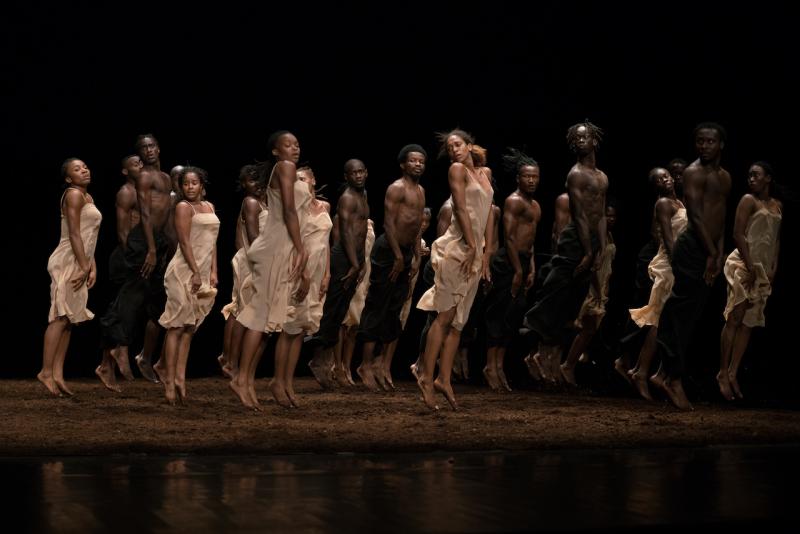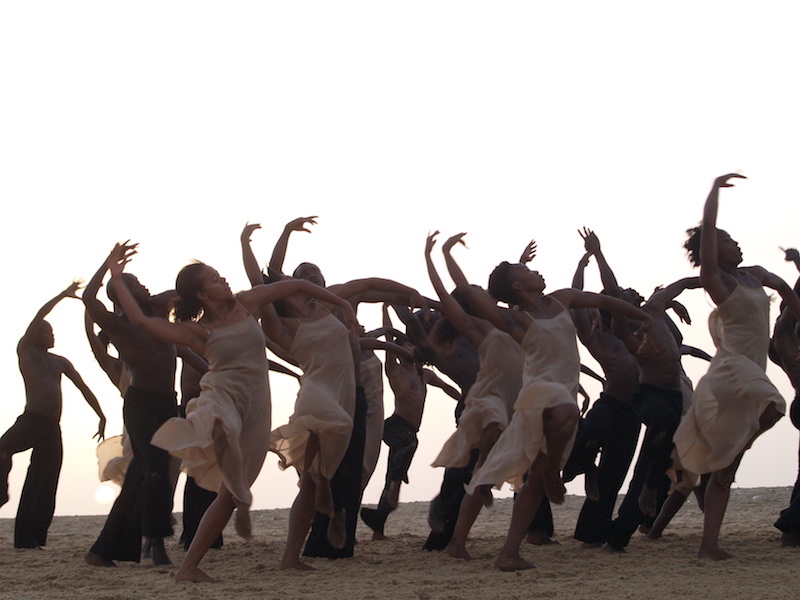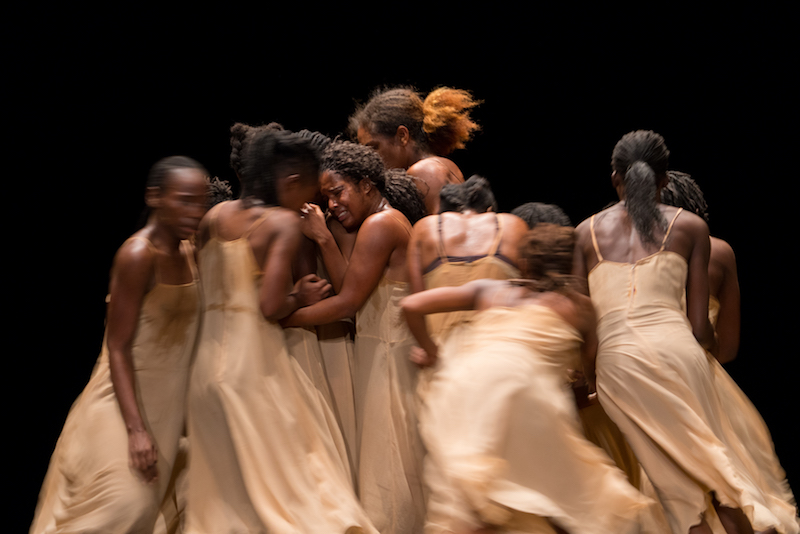The Rite of Spring, Pina Bausch/École des Sables, Sadler's Wells review - explosive and disturbing | reviews, news & interviews
The Rite of Spring, Pina Bausch/École des Sables, Sadler's Wells review - explosive and disturbing
The Rite of Spring, Pina Bausch/École des Sables, Sadler's Wells review - explosive and disturbing
At last, the pan-African production of Bausch's landmark choreography arrives on the London stage

Superstition, herd instinct, brutality, base terror. Whatever the precise narrative themes of Pina Bausch's response to The Rite of Spring – the most admired of dozens of dance settings of Igor Stravinsky’s score – it’s clear that it concerns aspects of behaviour deep-rooted in the human animal.
“How would you dance if you knew you were about to die?” was the question posed by the choreographer to her dancers back in 1975. And that visceral immediacy is brought to the fore by a 36-strong company of dancers assembled from across 14 African countries expressly for the performance of this landmark piece.
The project – directed by senior members of Bausch’s own company – should have landed at Sadler’s Wells more than two years ago, following a planned premiere in Dakar in March 2020. The timing could not have been worse. As borders were closed and public gatherings banned, the pan-African company decamped to the beach near their rehearsal base in Senegal for a final run-through that must, at the time, have felt like a desperate farewell to any hope for the world tour. But a documentary-maker was on hand to record it, and that film (pictured below) made on a West African beach and streamed by Sadler’s Wells became the biggest dance hit of lockdown.
Perhaps the most fascinating element of the work is the way the choreography counterpoints individuals and the mass, or rather masses: male and female. Bausch herds them as if they were sheep or wildebeest, and they respond in kind, complying then scattering in panic, or clustering in tight self-protecting groups. The sight is affecting at some very deep level, as can be seen in Wim Wenders’ 2011 film Pina, and indeed in the Senegal beach recording, made available for streaming once again by Sadler’s Wells. Exactly what the pan-African dancers bring to the piece as distinct from Bausch’s is hard to define. There is a strength and ferocity of execution that owes something to the performers’ mixed dance backgrounds – most of them originally trained in forms of African dance, not contemporary or ballet, and all were entirely new to Pina Bausch’s limb-wrenching yet very precise dance vocabulary. But there is also a beauty in their movement – whether running, falling, or airborne in statuesque poses – that derives from sheer bodily magnificence. Whatever long and painful effort it took to train such a disparate group into a fine-tuned ensemble, the result is superb.
Exactly what the pan-African dancers bring to the piece as distinct from Bausch’s is hard to define. There is a strength and ferocity of execution that owes something to the performers’ mixed dance backgrounds – most of them originally trained in forms of African dance, not contemporary or ballet, and all were entirely new to Pina Bausch’s limb-wrenching yet very precise dance vocabulary. But there is also a beauty in their movement – whether running, falling, or airborne in statuesque poses – that derives from sheer bodily magnificence. Whatever long and painful effort it took to train such a disparate group into a fine-tuned ensemble, the result is superb.
This hot-blooded production also releases Rite from the frozen Russian north of its origins to render it universal. More subtly, for a European audience – predominantly white – there is a disturbing low rumble of colonial guilt as the scenario plays out. While Stravinsky’s score may outline a story about the selection of a living human sacrifice and the dynamic between the victim and the mob, all we see on stage at Sadler’s Wells is victims. My guess is that the directors of this production intended this shift in perception, as too did Salomon Bausch, the son and heir of Pina, who sanctioned the African project. The one disappointment of the evening is the piped music, albeit in a fine vintage performance but poorly relayed to the auditorium. Unaccountably, neither orchestra nor conductor is credited in the programme.
rating
Explore topics
Share this article
The future of Arts Journalism
You can stop theartsdesk.com closing!
We urgently need financing to survive. Our fundraising drive has thus far raised £49,000 but we need to reach £100,000 or we will be forced to close. Please contribute here: https://gofund.me/c3f6033d
And if you can forward this information to anyone who might assist, we’d be grateful.

Subscribe to theartsdesk.com
Thank you for continuing to read our work on theartsdesk.com. For unlimited access to every article in its entirety, including our archive of more than 15,000 pieces, we're asking for £5 per month or £40 per year. We feel it's a very good deal, and hope you do too.
To take a subscription now simply click here.
And if you're looking for that extra gift for a friend or family member, why not treat them to a theartsdesk.com gift subscription?
more Dance
 'We are bowled over!' Thank you for your messages of love and support
Much-appreciated words of commendation from readers and the cultural community
'We are bowled over!' Thank you for your messages of love and support
Much-appreciated words of commendation from readers and the cultural community
 How to be a Dancer in 72,000 Easy Lessons, Teaċ Daṁsa review - a riveting account of a life in dance
Michael Keegan-Dolan's unique hybrid of physical theatre and comic monologue
How to be a Dancer in 72,000 Easy Lessons, Teaċ Daṁsa review - a riveting account of a life in dance
Michael Keegan-Dolan's unique hybrid of physical theatre and comic monologue
 A Single Man, Linbury Theatre review - an anatomy of melancholy, with breaks in the clouds
Ed Watson and Jonathan Goddard are extraordinary in Jonathan Watkins' dance theatre adaptation of Isherwood's novel
A Single Man, Linbury Theatre review - an anatomy of melancholy, with breaks in the clouds
Ed Watson and Jonathan Goddard are extraordinary in Jonathan Watkins' dance theatre adaptation of Isherwood's novel
 Peaky Blinders: The Redemption of Thomas Shelby, Rambert, Sadler's Wells review - exciting dancing, if you can see it
Six TV series reduced to 100 minutes' dance time doesn't quite compute
Peaky Blinders: The Redemption of Thomas Shelby, Rambert, Sadler's Wells review - exciting dancing, if you can see it
Six TV series reduced to 100 minutes' dance time doesn't quite compute
 Giselle, National Ballet of Japan review - return of a classic, refreshed and impeccably danced
First visit by Miyako Yoshida's company leaves you wanting more
Giselle, National Ballet of Japan review - return of a classic, refreshed and impeccably danced
First visit by Miyako Yoshida's company leaves you wanting more
 Quadrophenia, Sadler's Wells review - missed opportunity to give new stage life to a Who classic
The brilliant cast need a tighter score and a stronger narrative
Quadrophenia, Sadler's Wells review - missed opportunity to give new stage life to a Who classic
The brilliant cast need a tighter score and a stronger narrative
 The Midnight Bell, Sadler's Wells review - a first reprise for one of Matthew Bourne's most compelling shows to date
The after-hours lives of the sad and lonely are drawn with compassion, originality and skill
The Midnight Bell, Sadler's Wells review - a first reprise for one of Matthew Bourne's most compelling shows to date
The after-hours lives of the sad and lonely are drawn with compassion, originality and skill
 Ballet to Broadway: Wheeldon Works, Royal Ballet review - the impressive range and reach of Christopher Wheeldon's craft
The title says it: as dancemaker, as creative magnet, the man clearly works his socks off
Ballet to Broadway: Wheeldon Works, Royal Ballet review - the impressive range and reach of Christopher Wheeldon's craft
The title says it: as dancemaker, as creative magnet, the man clearly works his socks off
 The Forsythe Programme, English National Ballet review - brains, beauty and bravura
Once again the veteran choreographer and maverick William Forsythe raises ENB's game
The Forsythe Programme, English National Ballet review - brains, beauty and bravura
Once again the veteran choreographer and maverick William Forsythe raises ENB's game
 Sad Book, Hackney Empire review - What we feel, what we show, and the many ways we deal with sadness
A book about navigating grief feeds into unusual and compelling dance theatre
Sad Book, Hackney Empire review - What we feel, what we show, and the many ways we deal with sadness
A book about navigating grief feeds into unusual and compelling dance theatre
 Balanchine: Three Signature Works, Royal Ballet review - exuberant, joyful, exhilarating
A triumphant triple bill
Balanchine: Three Signature Works, Royal Ballet review - exuberant, joyful, exhilarating
A triumphant triple bill
 Romeo and Juliet, Royal Ballet review - Shakespeare without the words, with music to die for
Kenneth MacMillan's first and best-loved masterpiece turns 60
Romeo and Juliet, Royal Ballet review - Shakespeare without the words, with music to die for
Kenneth MacMillan's first and best-loved masterpiece turns 60

Add comment